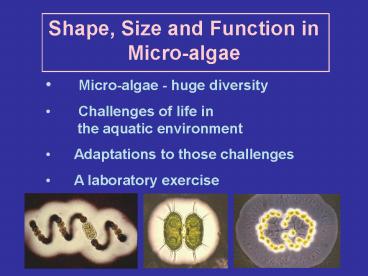Shape, Size and Function in Microalgae - PowerPoint PPT Presentation
1 / 25
Title:
Shape, Size and Function in Microalgae
Description:
Daily vertical migration of Volvox. Light. Which alga is best at avoiding being eaten? ... Volvox very large, spherical and able to move itself using flagella ... – PowerPoint PPT presentation
Number of Views:230
Avg rating:3.0/5.0
Title: Shape, Size and Function in Microalgae
1
- Shape, Size and Function in Micro-algae
- Micro-algae - huge diversity
- Challenges of life in the aquatic
environment - Adaptations to those challenges
- A laboratory exercise
2
1 / 100 mm 10 µm
1 / 10 mm
3
1 / 100 mm
4
1 / 100 mm
5
1 / 100 mm
6
Very dilute nutrients nitrate, phosphate
arrrrgghhh!
7
Extremely low concentrations of nutrients
Warm
More highly concentrated nutrients
Cold
8
Which alga is best at supplying itself with
mineral nutrients?
Spheres of increasing size
Cylinder the same volume as the middle sphere
9
Diameter Surface area Volume S / V
µm µm2
µm3
1 3.1
0.5 6 10 310
520 0.6 100
31,400 524,000 0.06
10
Diameter Surface area Volume S / V
µm µm2
µm3
1 3.1
0.5 6 10 310
520 0.6 100
31,400 524,000 0.06
50 long 595 520
1.1
11
Which alga is best at reducing the speed of
sinking?
arrrrgghhh!
12
V
Diameter 1 10
100
Sinking rate 1 100
10,000
13
All the same volume
Increasing Form resistance
14
Extremely low concentrations of nutrients
Ease of movement through the water an advantage.
Warm
More highly concentrated nutrients
Cold
15
(No Transcript)
16
Daily vertical migration of Volvox
Time4 pm
4 am
Light
0
Temp.
Depthm
Nutrients
50
17
Which alga is best at avoiding being eaten?
18
0.5 mm
19
(No Transcript)
20
(No Transcript)
21
(No Transcript)
22
Chlorella - small and spherical
- Absorbs nutrients efficiently
- Sinks very slowly
- Is easily eaten by Daphnia
23
Scenedesmus - intermediate size and
non-spherical
- Absorbs nutrients quite efficiently
- Sinks quite slowly
- Is eaten with some difficulty by Daphnia
24
Volvox very large, spherical and able to move
itself using flagella
- Slow growth, inefficient nutrient absorption
- In summer when water is stratified it can
move up to the light and down to nutrients - Cannot be eaten by Daphnia
25
(No Transcript)































